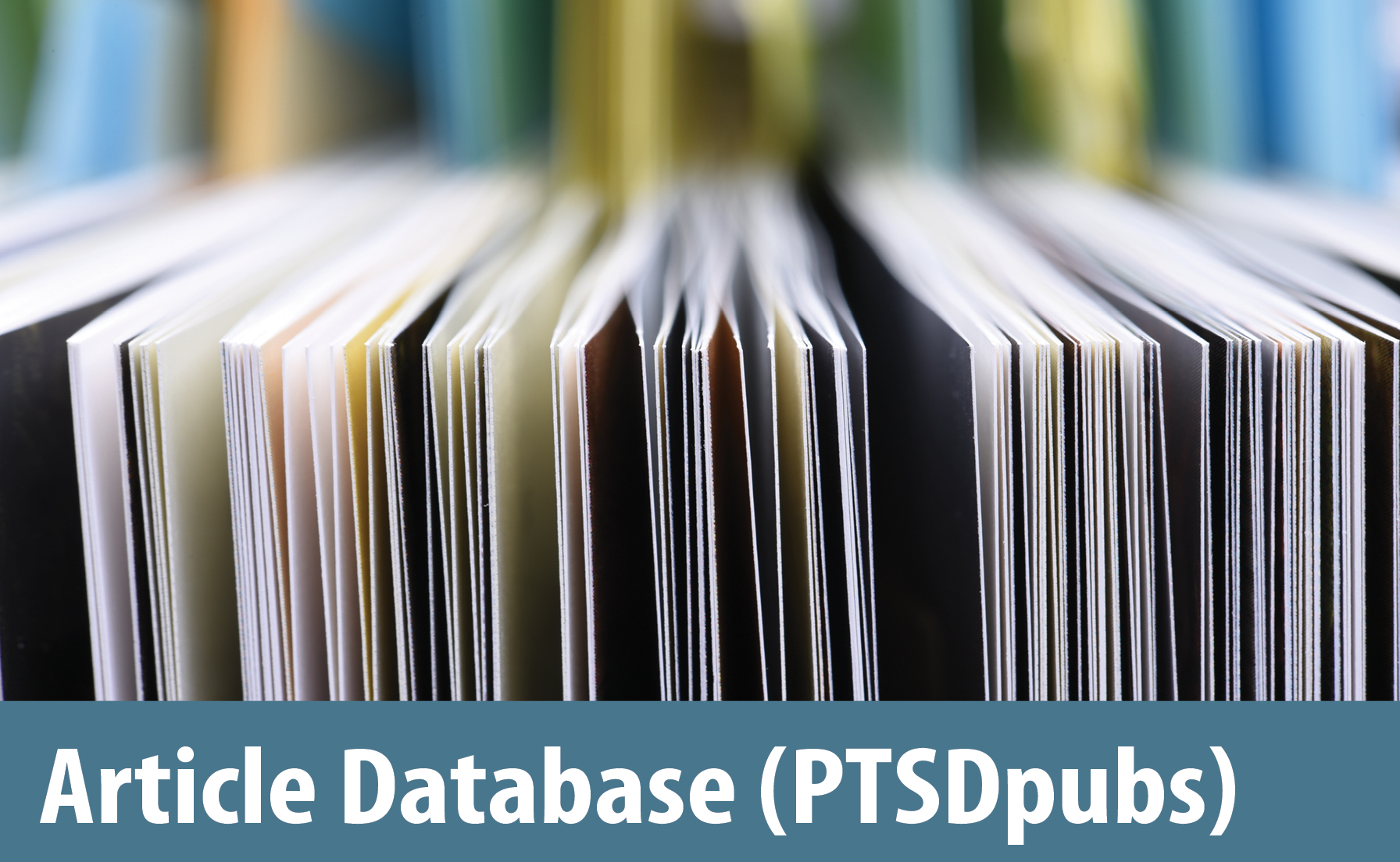Peacekeepers and Traumatic Stress
Peacekeepers and Traumatic Stress
US peacekeepers are military personnel, typically trained as combatants, who serve in missions in which they are charged with maintaining cease-fires, implementing peace settlements, or assisting in humanitarian operations (e.g., in Bosnia, Somalia, Lebanon). The psychological effects of peacekeeping vary and depend on the demands of each mission. The impact of the mission is influenced by the requirements of the mission, the degree of training and preparation the individual undergoes, the unique characteristics of the person, and the recovery environment.
Do Peacekeeping Missions Often Involve Traumatic and Highly Stressful Situations?
Stressors common to both peacekeeping and traditional war zone missions include sudden changes in lifestyle, separation from family, exhaustion, unfavorable climatic conditions, uncertainty about length of the mission, and demoralization about the efficacy of a mission. (1, 2) Unique stressors associated with peacekeeping missions (3, 4) include:
- Feelings of helplessness about reducing people's suffering and improving their safety
- Boredom
- Conflict about roles and duties
- Taunting and harassment by civilians
- Uncertainty about rules of engagement and conditions under which offensive action is defined as acceptable
In This Article
Additional stressors that are unique to peacekeeping include close proximity to potentially hostile individuals so that humanitarian assistance, protection, and deterrence can be provided. There is also the possibility of additional stress arising from the belief held by many peacekeepers that the stress they experience goes unrecognized by their families, friends, and governments (5). Research has demonstrated that these low-level stressors have a lasting negative psychological impact and can contribute to the development of PTSD (1).
While deployed, peacekeepers are often confronted with traumatic events that are typical of war zones. For example, they may witness death and dying, be charged with the clearing of civilian corpses, or be involved in serious accidents. Peacekeepers are sometimes confronted with unexploded land mines or fired upon as a result of misunderstandings. They may find themselves accidentally in the crossfire of two armed feuding parties or fired upon during "firing close," which is gunfire meant to intimidate the peacekeepers in order to keep them away from certain areas. Peacekeepers also sometimes witness the malicious destruction of property or atrocities committed against fellow peacekeepers and civilians.
Bramsen et al. (3) reported that 85% of the peacekeepers in their study had witnessed shootings, and 47% had seen dead or wounded people. The nature and frequency of potentially traumatic events will vary tremendously with different peacekeeping missions. Peacekeeping missions range from benign observer operations (e.g., Sinai) to highly dangerous peace-enforcement missions (e.g., Somalia and Bosnia).
What Is the Prevalence of PTSD Following Peacekeeping Operations?
In an investigation of Norwegian peacekeepers who served in the United Nations Interim Force in Lebanon, Weisaeth, Mehlum, & Mortensen (5) documented that 15% of those who completed their service developed PTSD. Twenty-five percent of those who had their service interrupted due to disciplinary, social, or medical problems developed PTSD. Litz, Orsillo, Friedman, Ehlich, and Batres (7), in a large-scale investigation of 3,461 U.S. servicemen and women, found that approximately 8% of American peacekeepers in Somalia met criteria for PTSD five months after their return to the United States. In contrast, Bramsen et al. (3) reported that although more than one fifth of their sample reported at least some significant PTSD symptoms, only 3% of Dutch peacekeepers in the former Yugoslavia developed PTSD. Studies have demonstrated that, in addition to those who develop full PTSD, many more peacekeepers will suffer from significant, if sub-threshold, levels of PTSD symptoms.
Prevalence rates of PTSD following peacekeeping operations may also vary as a function of the time elapsed between the end of a mission and the psychological evaluation. For instance, during a two-year longitudinal study of New Zealand peacekeepers, MacDonald, Chamberlain, Long, Pereira-Laird, and Mirfin (8) found that psychological distress was quite high at predeployment and at follow-up, but it was significantly lower during the mission itself. These findings are consistent with O'Brien's (5) observation that the presentation rate of psychiatric difficulties during war is quite low and that many soldiers develop difficulties after their service periods are over. Because of this, if researchers make estimates of the incidence of PTSD immediately or very soon after missions end, they may be underestimating the full extent of distress incurred by peacekeepers.
What Are the Risk and Resiliency Factors Associated with Peacekeeping Missions?
A few studies have examined risk and resiliency factors in peacekeepers. Less psychological distress postdeployment has been linked to a number of factors:
- Self-disclosure
- Availability of social support
- Positive homecoming receptions
- Fewer additional life stressors
- Feeling more positive about military cohesion and morale during their deployment (9)
- Feeling less frustration with aspects of the mission
Furthermore, Bramsen and colleagues (3) have identified two predeployment personality traits that are significant predictors of PTSD. Individuals who scored higher on scales of negative, hostile, or a generally dissatisfied outlook on life and individuals who scored higher on scales assessing highly suspicious or paranoid thoughts were more likely to develop PTSD following peacekeeping missions.
Conclusions
The majority of soldiers deployed as peacekeepers cope very well with the demands of peacekeeping and do not develop significant psychological distress. However, PTSD and other forms of psychological distress, such as depression and alcoholism, do occur following deployment in a notable percentage of peacekeepers. Although peacekeeping operations have historically been viewed as relatively benign compared to traditional combat missions, these operations frequently involve changeable goals, ambiguous rules of engagement, civilian combatants, and exposure to the aftermath of violence or ongoing atrocities. Researchers have begun to outline factors associated with risk and resilience so that negative psychological consequences may be reduced and the peacekeepers most adversely affected can be identified.
References
- King, D.W., King, L.A., Foy, D.W., Keane, T.M., & Fairbank, J.A. (1999). Posttraumatic stress disorder in a national sample of female and male Vietnam veterans: Risk factors, war-zone stressors, and resilience-recovery variables. Journal of Abnormal Psychology, 108, 164-170.
- Rosebush, P.A. (1998). Psychological intervention with military personnel in Rwanda. Military Medicine, 163, 559-563.
- Bramsen, I., Dirkzwager, A.J.E., & Van der Ploeg, H.M. (2000). Predeployment personality traits and exposure to trauma as predictors of posttraumatic stress symptoms: A prospective study of former peacekeepers. American Journal of Psychiatry, 157(7), 1115-1119.
- Litz, B.T., King, L.A., King, D.W., Orsillo, S.M., & Friedman, M.J. (1997). Warriors as peacekeepers: Features of the Somalia experience and PTSD. Journal of Consulting and Clinical Psychology, 65(6), 1001-1010.
- OâBrien, L. S. (1994). What will be the psychiatric consequences of the war in Bosnia? A bad war from the psychiatric point of view, leading to hidden pathology. British Journal of Psychiatry, 164, 443-447.
- Weisaeth, L., Mehlum, L., & Mortensen, M. (1996). Peacekeeper stress: New and different? National Center for PTSD Clinical Quarterly, 6, 12-15.
- Litz, B.T., Orsillo, S.M., Friedman, M., Ehlich, P., & Batres, A. (1997). Post-traumatic stress disorder associated with peacekeeping duty in Somalia for U.S. military personnel. American Journal of Psychiatry, 154, 178-184.
- MacDonald, C., Chamberlain, K., Long, N., Pereira-Laird, J., & Mirfin, K. (1998). Mental health, physical health, and stressors reported by New Zealand defense force peacekeepers: A longitudinal study. Military Medicine, 163, 477-481.
- Litz, B.T. (1996). The psychological demands of peacekeeping for military personnel. National Center for PTSD Clinical Quarterly, 6, 1-8.
You May Also Be Interested In

Continuing Education Online Courses
Learn from expert researchers and earn free Continuing Education (CE) credits.

























